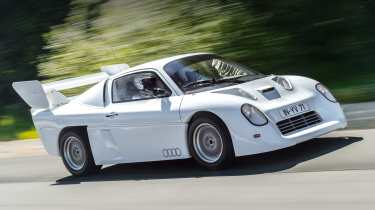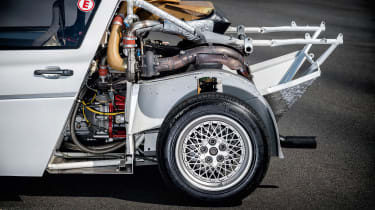Mid-engined Audi Quattro – Dead on arrival
When Lancia and Peugeot threatened Audi’s early-’80s rallying dominance, a secret plan was hatched to build a new car. But one photo was all it took to stop the mid-engined Quattro in its tracks
The Audi Quattro may have shaken up rallying but its reign as king of the special stage was short-lived. After taking the 1982 world championship, the loss of the ’83 title to the mid-engined Lancia 037 gave a hint of the Quattro’s weak spot, and the arrival of the Peugeot 205 T16, which was mid-engined and four-wheel-drive, hammered home the problem.
Audi tried to stay in the game with the Sport Quattro of 1984, addressing works drivers’ concerns about agility with a shorter wheelbase, but this effort gave so little benefit that Hannu Mikkola and eventual ’84 world champion Stig Blomqvist were in no hurry to switch from their original, long-wheelbase Quattros. For 1985 the E2 evolution tried to lessen the car’s nose-heavy weight distribution but it was glossing over the real problem: to stay competitive in Group B rallying, Audi needed a mid-engined car.
> Audi RS3 2021 review - Audi Sport set to take on AMG’s A45S
Unfortunately, Audi’s marketing people and their masters at Volkswagen weren’t keen to undermine the Quattro road car by suggesting that its layout was imperfect. Nor for that matter was Ferdinand Piëch, Quattro creator and second in command at Audi. Despite this, Audi Sport boss Roland Gumpert began an under-the-radar programme to make a mid-engined rally fighter in parallel to development of the officially sanctioned Sport Quattro. This off-the-books plan was assembled in such secrecy that once a running prototype was completed in late 1984 it was shipped to a test facility behind the Iron Curtain where shakedown testing could begin without fear of being found out. In early 1985, however, the mid-engined Quattro was brought closer to home and during testing in Austria this officially non-existent machine was papped by Motorsport aktuell, who ran a fuzzy shot of it under the cutting headline: ‘Audi’s new rally bomb – two years too late?’
The fallout was immediate. Volkswagen bosses were deeply displeased to discover a new rally car was being developed without their consent and within 48 hours of the photo appearing in print Ferdinand Piëch personally saw to the destruction of everything relating to the mid-engined Quattro project. Some reports claim Piëch knew nothing of this car before the Austrian magazine scoop. After all, if you were covertly redesigning the Quattro, would you dare tell the father of the Quattro himself? Other accounts say he gave Gumpert tacit approval because, though he loved the Quattro, he also loved presiding over a company that could dominate rallying by whatever means. Either way, to avoid further angering his VW superiors, Piëch had to erase all trace of the mid-engined Quattro.
But that didn’t quite happen. In the 1990s the car you see here was unearthed in the bowels of an Audi facility. It’s not one of the original pair of mid-engined prototypes – they looked like Ur-Quattros but with air intakes behind the doors and stubbier overhangs – and nor was it aimed at Group B rallying. This seems to be a mutation of those cars, created in a separate workshop away from Audi Sport HQ under the code name RS 002, and designed to compete in Group S, the proposed hardcore ‘prototype’ class of rallying culled after the Group B fatalities of 1986.
When this crudely made proof-of-concept was exhumed, it was dusted off and rolled into Audi’s museum where it remained as a static exhibit until 2016, when the company’s heritage division got its five-cylinder engine running again. Since then this wonderful curio has been brought out to play in the hands of ex-works drivers Hannu Mikkola and Walter Röhrl, the very men who could have used it to win world championships if only management had been open to the idea of a mid-engined Quattro.








